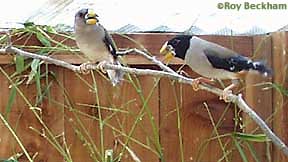|
Common Names
Blacktailed Hawfinch, Yellow-billed Grosbeak
Description
Definitely a large finch at nearly 7 inches long. A stocky bird with full body. I have not had them for very long at this point (many were imported in early 2000). I'll admit that I'm a little intimidated by these guys. They say that they can crack a cherry pit! That's more of a pinch than I'd like to endure. Both the male's and female's beaks are entirely yellow during the winter, but gains a black tip in the spring. Sexes are easily distinguished by the male's black cap. The Japanese Grosbeak is similar, but the black cap of the Japanese Grosbeak does not extend past the ears.
Diet
These birds are real safflower pigs. They will eat lots and lots of safflower and small black sunflower. I also offer milo, parakeet mix, wheat, oats and gamebird crumbles. They will take thawed frozen peas with great gusto. I have offered them my egg food, but they never ate very much of it. Because of that and the fact that I supply vitamins in my egg food, I provide vitamins in their water. The only other food that they REALLY like is waxworms. They would eat 10-20 a day. They would have probably eaten more, but that's all I gave them. These will likely be key to getting them into condition to begin breeding and essential to success should they decide to sit and raise any young. The number that they will likely eat at that point is sure to be phenomenal.
Breeder's Notes
To date I have not had any breeding attempts by my pair, but I really didn't expect any. Maybe in the spring of 2001 I may see some activity. When I had them indoors under extended lighting the male was singing quite often. It is a melodious song that will put a mockingbird to shame. He would often sing at night. I can't wait for spring to hear those songs again.
An importer conveyed to me his personal experience of a pair he had that laid eggs in an open nest. The nest was actually a kid's easter basket tied to the cage. A nest was constructed by another species that had occupied the cage before. My hope is to get at least that far. Even fertile eggs I can place in the incubator and hand raise would be considered a success. (10/00)
(Update: 2/2002) After losing one after the other, it was clear that I was missing something in their diet or that they were susceptable to something in my aviary environment. I have since abandon my attempts to breed this species. All my research indicates that there have only been a couple of successful breedings of the Chinese Grosbeak. Even those were not entirely successful. European authors have indicated that the birds can be enticed to lay and even sit, but often abandon the clutches before the chicks are independent. While this is a beautiful species and can make excellent and long lived aviary pets, because of the apparent lack of breeding success, it is doubtful that the species will ever become established as a free breeding avicultural specimen.
Additional Notes
I understand that these birds are highly territorial so it is best to house no more than one pair per flight. You should not house them with other closely related species either, these include the Japanese Grosbeak, the Black and Yellow Grosbeak or the Collared Grosbeak. Other Grosbeaks and the true hawfinch should probably not be housed with them either. I have them housed with Spice finches, Red Headed finches and some Mountain Quail. There doesn't appear to be any problems with this group.
|











